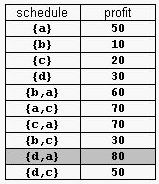POJ 1456 Supermarket【貪心+並查集】
阿新 • • 發佈:2019-02-10
Supermarket
For example, consider the products Prod={a,b,c,d} with (pa,da)=(50,2), (pb,db)=(10,1), (pc,dc)=(20,2), and (pd,dd)=(30,1). The possible selling schedules are listed in table 1. For instance, the schedule Sell={d,a} shows that the selling of product d starts at time 0 and ends at time 1, while the selling of product a starts at time 1 and ends at time 2. Each of these products is sold by its deadline. Sell is the optimal schedule and its profit is 80.

Write a program that reads sets of products from an input text file and computes the profit of an optimal selling schedule for each set of products.
| Time Limit:2000MS | Memory Limit:65536K |
| Total Submissions:11450 | Accepted:5053 |
Description
A supermarket has a set Prod of products on sale. It earns a profit px for each product x∈Prod sold by a deadline dx that is measured as an integral number of time units starting from the moment the sale begins. Each product takes precisely one unit of time for being sold. A selling schedule is an ordered subset of products Sell ≤ Prod such that the selling of each product x∈Sell, according to the ordering of Sell, completes before the deadline dx or just when dx expires. The profit of the selling schedule is Profit(Sell)=Σx∈SellFor example, consider the products Prod={a,b,c,d} with (pa,da)=(50,2), (pb,db)=(10,1), (pc,dc)=(20,2), and (pd,dd)=(30,1). The possible selling schedules are listed in table 1. For instance, the schedule Sell={d,a} shows that the selling of product d starts at time 0 and ends at time 1, while the selling of product a starts at time 1 and ends at time 2. Each of these products is sold by its deadline. Sell is the optimal schedule and its profit is 80.

Write a program that reads sets of products from an input text file and computes the profit of an optimal selling schedule for each set of products.
Input
A set of products starts with an integer 0 <= n <= 10000, which is the number of products in the set, and continues with n pairs pi di of integers, 1 <= pi <= 10000 and 1 <= di <= 10000, that designate the profit and the selling deadline of the i-th product. White spaces can occur freely in input. Input data terminate with an end of file and are guaranteed correct.Output
Sample Input
4 50 2 10 1 20 2 30 1 7 20 1 2 1 10 3 100 2 8 2 5 20 50 10
Sample Output
80 185
Hint
The sample input contains two product sets. The first set encodes the products from table 1. The second set is for 7 products. The profit of an optimal schedule for these products is 185.Source
Southeastern Europe 2003題目大意:有n個商品,每個商品都有一個值,第一個是其價值,第二個是其過期日期,每一天只能賣一件商品,問最大利潤。
思路:
按照商品價值從高到低排序,然後從高到低遍歷,如果當前商品的截止日期沒有分配任務,那麼就在這個日期上分配當前商品任務,如果截止日期上已經分配了商品任務了,就向前遍歷日期,看哪一天空閒,然後在這個空閒的日期上分配當前商品任務,如果從當前商品任務的截止日期到第一天都有商品任務分配了,那麼就說明這個商品任務沒有必要完成了。
網上看到有很多大牛用並查集來優化問題,嘗試了一發,的確是快了很多,具體操作為這樣:
初始的時候,將每個f【】都設定自身為根節點,在遍歷當前任務的時候,令ff=find(a【i】.day),如果ff>0那麼設定上這個日期分配當前任務,並且使得f【ff】=ff-1,這樣就達成了上述最開始思路的操作了。
AC程式碼:
#include<stdio.h>
#include<string.h>
#include<algorithm>
#include<iostream>
using namespace std;
struct node
{
int val,day;
}a[100000];
int f[100000];
int cmp(node a,node b)
{
return a.val>b.val;
}
int find(int a)
{
int r=a;
while(f[r]!=r)
r=f[r];
int i=a;
int j;
while(i!=r)
{
j=f[i];
f[i]=r;
i=j;
}
return r;
}
void merge(int a,int b)
{
int A,B;
A=find(a);
B=find(b);
if(A!=B)
f[B]=A;
}
int main()
{
int n;
while(~scanf("%d",&n))
{
int maxday=0;
for(int i=0;i<n;i++)
{
scanf("%d%d",&a[i].val,&a[i].day);
maxday=max(maxday,a[i].day);
}
int output=0;
for(int i=1;i<=maxday;i++)f[i]=i;
sort(a,a+n,cmp);
for(int i=0;i<n;i++)
{
int ff=find(a[i].day);
if(ff>0)
{
f[ff]=ff-1;
output+=a[i].val;
}
}
printf("%d\n",output);
}
}
